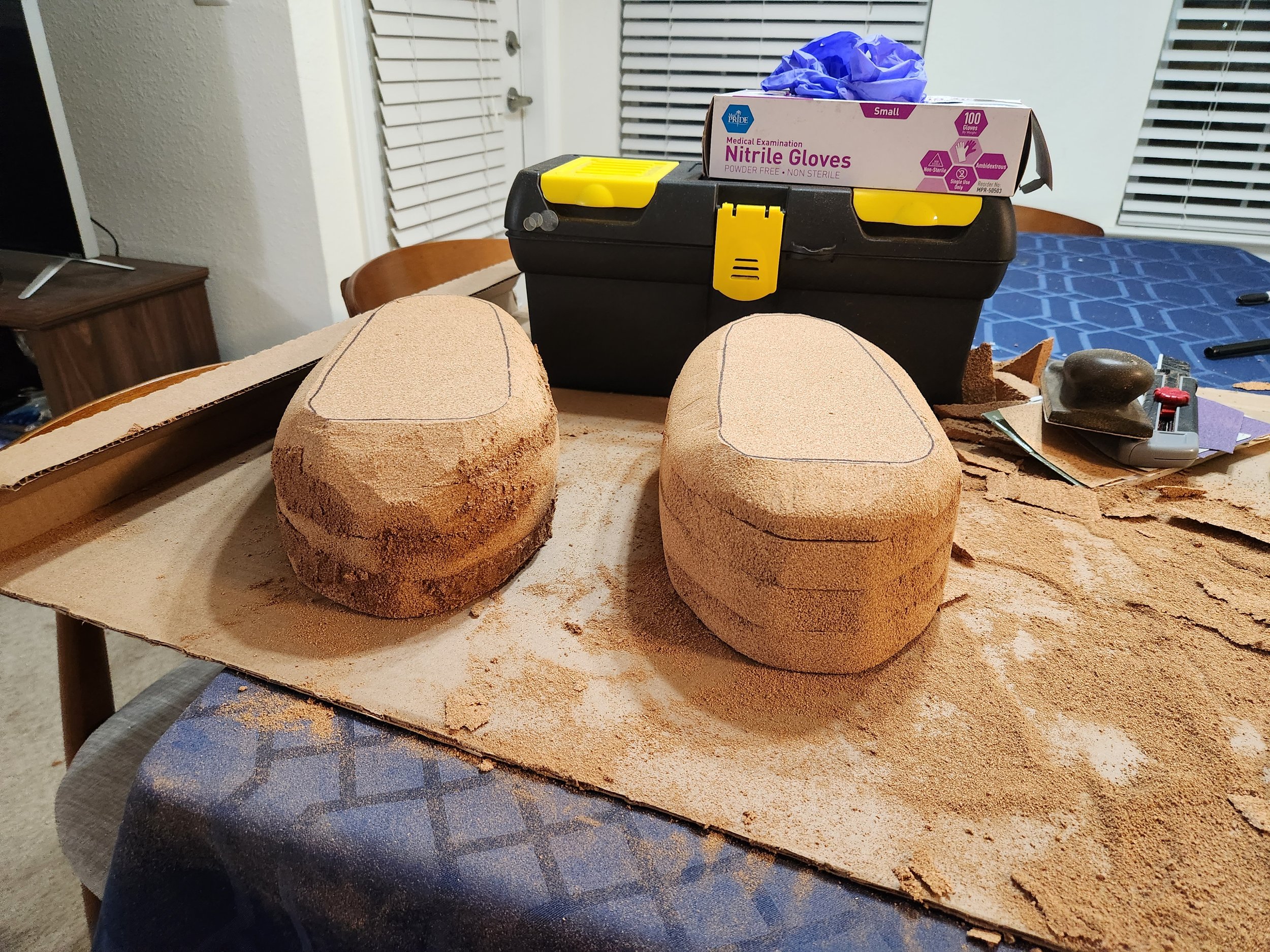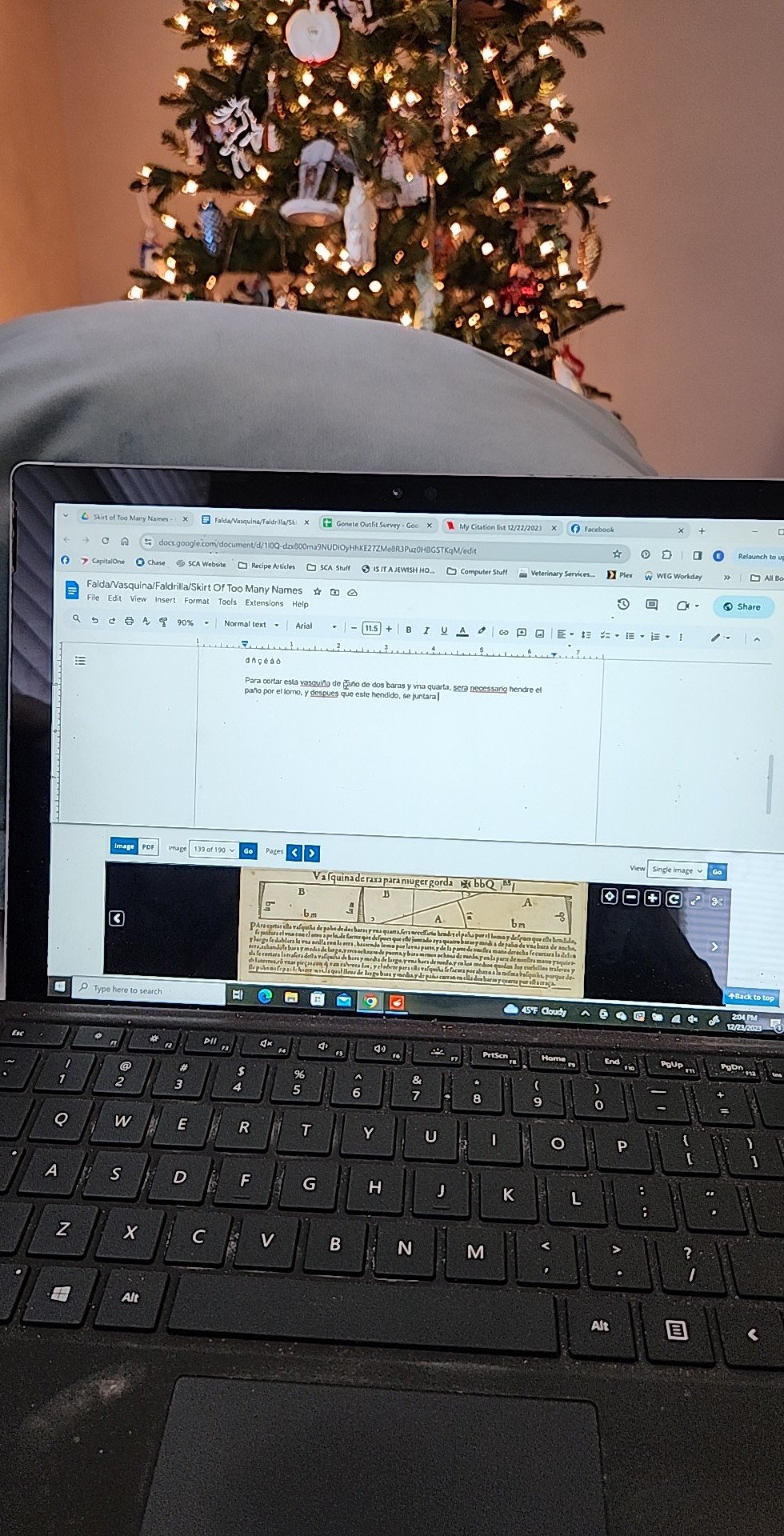December 2023: Failing Upwards at Geometry
December started off with a serious push to complete the Red Gonete. The body was done and all it really needed were sleeves. I was able to complete it after I returned home from a work trip early in the month and I am so thrilled with how it turned out. It still needs a wear test, but I am pretty confident in the changes made and saying third time’s the charm. That’s one Pentathlon piece completed!
The same sewing day I finished the sleeves at, I also tested a 4th iteration of the almodrote. I’m really thrilled flavor-wise how this one turned out. I was trying very hard to sort out imparting smoke flavor in such a way that was fire safe in my apartment and I think I’ve hit that. I also tested out a cheese blend and am quite pleased with that as well. The one thing that did go wrong was the texture. The new cooking method for the chicken produced a LOT more pot drippings than previous iterations, and as such, my sauce had too much liquid in it. I’m going to cut back the broth content approximately in half and I think that should just about balance it out. The goal is enough broth to melt the cheese, but not so much that it makes the sauce too loose. After a small test just for texture, I’m quite pleased with the results, so that’s another Pentathlon piece wrapped as well!
My documentation has been my travel project this whole month and I have spent a LOT of time traveling. I was on a plane every single week of December, and it gave me plenty of time to work on documentation for all my in progress or completed Pentathlon pieces. I reformatted the data that the gonete, skirt, and chapines all rely on, with the ultimate goal with that reformatting is to be able to quantify the trends specifically in Castile. Since the persona I both play and am entering is specifically Castilian, I want to demonstrate specific Castilian styles and why they were chosen for her. I also did some good digging back into my sources for the chapines and the commonplace book, and I’m making some good progress both of those sets of documentation as well. I was able to fully complete the documentation for the almodrote and the gonete, and make major headway on the documentation for the remaining pieces as well.
Apartments are not made for this sort of work.
The materials for the chapines arrived just as I was getting back from my second work trip of the month and I immediately wanted to dive right in. Thankfully, with the revisiting of my research, I had a pretty solid grasp of how I wanted to proceed and construct these pieces. There was a non-zero amount of “how hard could it really be” going on, but after several hours of sawing, whittling, sanding, and gluing, I had some pretty reasonably shaped pieces! This project is definitely one I would highly recommend doing with power tools like a power saw and belt sander, but I think by the end of this, I’m going to have a very high level of respect for the tapineros who made them in period.
When I ordered the leather for the outside of the chapines, I also ordered a few pre-cut panels of some thinner dyed leathers, one of which is this gorgeous red, incredibly thin lamb leather. Towards the end of the month, I made some delightful turn shoe slippers out of it that can be worn with these chapines. I also got a single sheet of navy blue leather that I need to come up with a plan for. If it comes back into stock, it may be a candidate for another pair of shoes.
I am incredibly lucky to work at a company that’s able to close the week between Christmas and New Years so I made the most of that time to really make some progress on these pieces. I’m definitely still feeling a little bit out of my depth, but these have been such a fantastic opportunity to try a few kinds of A&S I have always been curious about and to explore more truly that “persona from head to toe” mentality.
To say the chapines have been a challenging project would be an understatement. With 15 hours already under my belt on them, the platforms are fully shaped and the soles are cut. The leather I got turned out to have additional treatments done to it, making it entirely unsuitable for stamping. Having to completely revisit my main material set me way back on this project and it will not be complete enough to wear to 12th Night with my green saya. In January, I’ll make some headway on finding a more suitable leather piece for these and plan to go in person this time to guarantee I’ve chosen the correct material. I am still hopeful that I can complete them reasonably quickly once I’m able to get things moving again on materials.
I have been noodling around how I want to approach the skirt, which is the last of the three components of this outfit. I know my general design aesthetic goals, drawing on the learning I’ve had from the survey of outfits as a whole. I’m trying to focus the outfit heavily on the women of Castile from Gaignieres and the black and whites from Anderson. I’m hoping that leaning into a combination of Alcega’s patterns and the paintings will constitute sufficient documentation. Since none of Alcega’s patterns (that I know of/were available in the Library of Congress scan I used) really line up with the gonete, the documentation there relies entirely on the data gathered from paintings and overall knowledge of garment making in the period. I did ultimately decide to invest in a copy of Modern Maker Vol 1 to see how Matthew Gnagy approaches the bara system of measurements, since his is a widely used interpretation of Alcega’s measurement system. I ended up getting some fabric tape and making my own two bara tapes using Gnagy’s method (one for based on chest measurements and one on height). I don’t have a use for the chest measurement tape, but I’ll use the height tape to make my skirt pattern.
In doing the above, I found the Library of Congress listing for Alcega’s Libro de Geometría, practica, y traça (Book on Geometry, Practice, and Pattern). There are scanned images of each page, and each image includes the pattern layout and some instructions for cutting the items. Interestingly, there are sparse instructions regarding the construction, so I believe this resource would only be used by knowledgeable tailors in period. I ended up going down a rabbit hole on translation to compare how each of the patterns differed and in the process got a good idea about how Alcega thinks about patterns as well. I think this makes a great addition to my documentation for Pentathlon and I’m excited to include it.
With the translations complete and fabric prepped, I settled on which Alcega pattern I plan to use for my vasquiña. I wasn’t able to actually start cutting into it, because the original twill tape I got for the bara tapes turned out to be an absolute dud (the markers I used to write on it bled so badly I couldn’t read the symbols), but I did acquire replacement tape and hope to start doing the patterning and cutting first thing in January. My hope is to have this be my travel project/12th Night project, then come home and be able to start attaching the ribbons for the ornamentation. I was able to get some lovely silk ribbon for this on a nice sale at Renaissance Fabrics. It’s not technically a true gold, but I love that pale champagne gold look of the ribbons so I’m ok with that.
In prepping for cutting this project, I did have to come to terms with the fact that apparently, I have a fundamental misunderstanding of how rectangles work. I prepped for using the tapes by doing the actual math of the measurements and lengths to use on the pattern. This revealed that I’d made an incorrect assumption about the folding method in Alcega’s patterns and revealed some interesting differences in methodology for actually assembling the skirt. Realizing this before it came time to cut the pieces out was a boon though, and has greatly increased my understanding of Alcega’s methods.
I did submit my class proposal for Winter University. I’m doing something a little different again, and instead of focusing on one of my areas of interest/study, I’m actually focusing on my office as the Editor of The Oak. I’m hoping to use that platform and voice to help bring attention to the many ways arts and sciences can happen online and the resources available to people to make that happen. The Oak has been such a great part of my life over this last year and I’ve learned a lot from both that team and running this site that hopefully will be useful to anyone who wants to show off their own art or to encourage someone they know to do the same. That does mean I’ll need to work on a slide deck before early February but that shouldn’t be too much of a hassle. I do intend to record that class and finally upgrade my storage on this site to continue hosting recordings here.
Totally unrelated to any planned A&S, I tried something new as a Hannukah present for my mom. I’d been seeing recipes float around the internet for this for a little while and have taken SCA classes on the topic before, so I tried my hand at making homemade limoncello. It’s adjacent to the cordials I’ve taken classes on, and I was really excited to try something new. I’m really pleased with how it turned out. It’s a beautiful floral lemon flavor without being too bitter. I’m considering trying some more SCA appropriate cordials next year after Pentathlon efforts wrap up.
So, as 2023 comes to a close, my major project status is as follows:
Almodrote que es capriotada: recipe finalized, display planned, documentation complete.
Gonete: item completed, documentation completed, display somewhat planned.
Skirt: design complete, materials acquired, display somewhat planned, documentation in progress.
Chapines: item in progress, display somewhat planned, documentation in progress.
Commonplace book: item in progress, display planned, documentation in progress.
My January goals can be summed up pretty reasonably: complete the two remaining Pentathlon items that I can actually make progress on easily (meaning the commonplace and the vasquiña). I don’t think I’ll get anywhere close to finishing the chapines in January, but that leaves all of February to finish them and finalize any remaining documentation and display plans.
Complete the commonplace book.
Complete the vasquiña.
Prep University class materials.
Find new material for the chapines.



